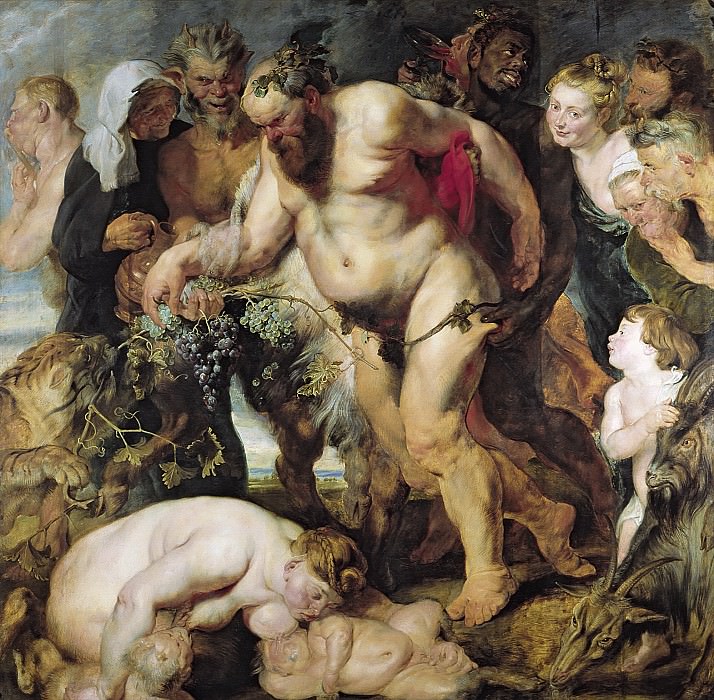Drunken Silenus Peter Paul Rubens (1577-1640)
Peter Paul Rubens – Drunken Silenus
Edit attribution
Download full size: 2000×1963 px (1,2 Mb)
Painter: Peter Paul Rubens
The works painted by the famous Flemish painter Peter Paul Rubens belong to Baroque painting. One of the most famous works by the painter is considered to be a depiction of Seelen. This picture is also commonly referred to as "Drunken Silen". In Greek mythology, Silenus was considered one of the village gods. He appeared to people in the form of a jolly old man, drunk, but at the same time very wise and possessing the gift of prophecy.
Description of Peter Rubens’ painting "The Drunken Silenus"
The works painted by the famous Flemish painter Peter Paul Rubens belong to Baroque painting. One of the most famous works by the painter is considered to be a depiction of Seelen. This picture is also commonly referred to as "Drunken Silen".
In Greek mythology, Silenus was considered one of the village gods. He appeared to people in the form of a jolly old man, drunk, but at the same time very wise and possessing the gift of prophecy. That is why most paintings depicted him as drunk, sprawled out on his back or supported on both sides. He could also be portrayed in a donkey-drawn carriage, but always drunk, cheerful and contented.
In his painting Rubens also depicted Silenus as a drunken man unable to move around on his own. He is supported by a satyr who helps him stay on his feet. All this takes place surrounded by beautiful nymphs, little cupids and Menade (a beautiful admirer of Dionysus). In his creation, the painter wanted to depict the earthly origins emanating from nature, fertility and joyous noise. And he succeeded in this very well.
The work maintains a noisy atmosphere of bacchanalia. The faces of the nymphs and satyrs are cheerful and contented. And the delicate sprig of ripe grapes, as the main source of wine, symbolizes the holiday and festivities. The painting is distinguished by its sketchy free technique and variety of colors. At the same time, all the variety of colors and shades are combined into a solid golden stream, reflecting the movement of the human body on the one hand, and the air masses on the other.
In his work the talented artist portrayed mythical gods of elements and fertility, rich harvests, who originated the natural beginning of mankind as lovers of holidays, festivities and fun. They act as a symbol of endless noise and joie de vivre.
Кому понравилось
Пожалуйста, подождите
На эту операцию может потребоваться несколько секунд.
Информация появится в новом окне,
если открытие новых окон не запрещено в настройках вашего браузера.
You need to login
Для работы с коллекциями – пожалуйста, войдите в аккаунт (open in new window).




















You cannot comment Why?
The painting can be interpreted on multiple levels. Silenus, a follower of Dionysus, the god of wine, represents intoxication and unrestrained revelry. His drunkenness is a symbol of the liberating, and sometimes dangerous, power of wine and ecstatic indulgence. The presence of satyrs and fauns further emphasizes the theme of wild, primal nature and its connection to pleasure. The surrounding figures, a mix of humanity and the mythical, witness this scene, highlighting the human fascination with and susceptibility to such excesses.
However, the painting also carries deeper subtexts. The tender depiction of the infants at the bottom, particularly the suckling child, introduces a contrast between the abandoned revelry above and the nurturing innocence of new life. This juxtaposition can be seen as a commentary on the cycle of life, where indulgence and primal instincts exist alongside responsibility and tenderness. Furthermore, the inclusion of a diverse range of figures, including the black man and varied human onlookers, speaks to a certain inclusivity within the Dionysian myth, suggesting that these revelries are a universal human experience, transcending social or ethnic boundaries. The painting can thus be viewed as an exploration of the duality of human nature – the capacity for both wild abandon and gentle care, for primal urges and civilized observation, all under the pervasive influence of Dionysian spirit, represented by the drunken Silenus.